Group Behavior Analysis: Decision-Making in PR & HR Groups
VerifiedAdded on 2023/04/08
|18
|4354
|63
Essay
AI Summary
This essay provides a comprehensive analysis of group behavior, focusing on decision-making processes within two distinct groups: PR and HR. The study examines the application of various group behavior concepts and theories, comparing and contrasting functional behaviors (those that enhance group performance) with dysfunctional behaviors (those that hinder performance). The essay explores the stages of group development, the rational decision-making model, and the impact of leadership styles and communication processes. It delves into specific challenges faced by each group, such as conflicts, lack of transparency, and the absence of clear leadership roles. The analysis highlights how these factors influence the ability of each group to achieve its objectives. The essay also discusses the importance of teamwork, communicative processes, and self-confidence in fostering effective decision-making. The conclusion offers recommendations aimed at improving group performance by addressing the identified dysfunctional behaviors and promoting a more cohesive and productive environment within each group.
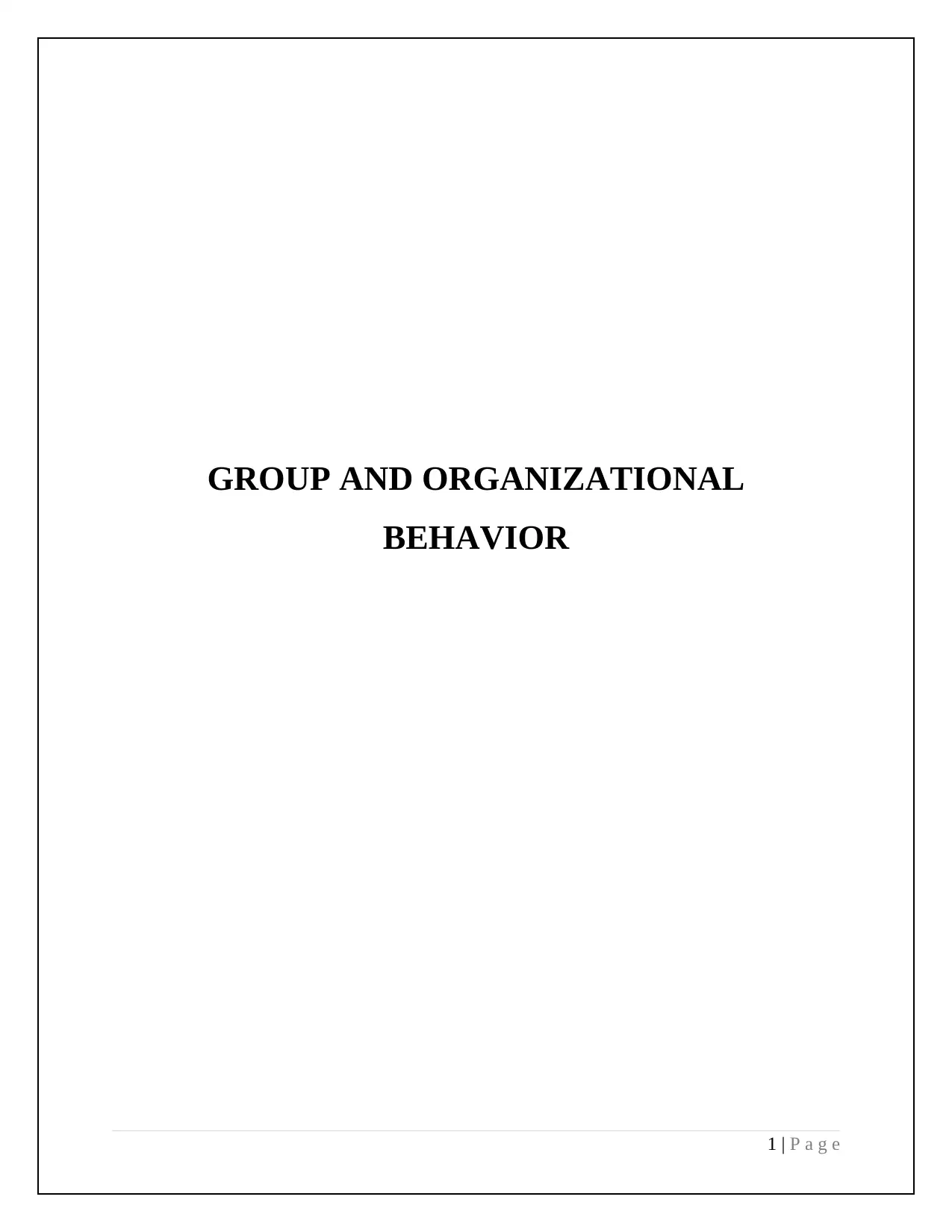
GROUP AND ORGANIZATIONAL
BEHAVIOR
1 | P a g e
BEHAVIOR
1 | P a g e
Paraphrase This Document
Need a fresh take? Get an instant paraphrase of this document with our AI Paraphraser
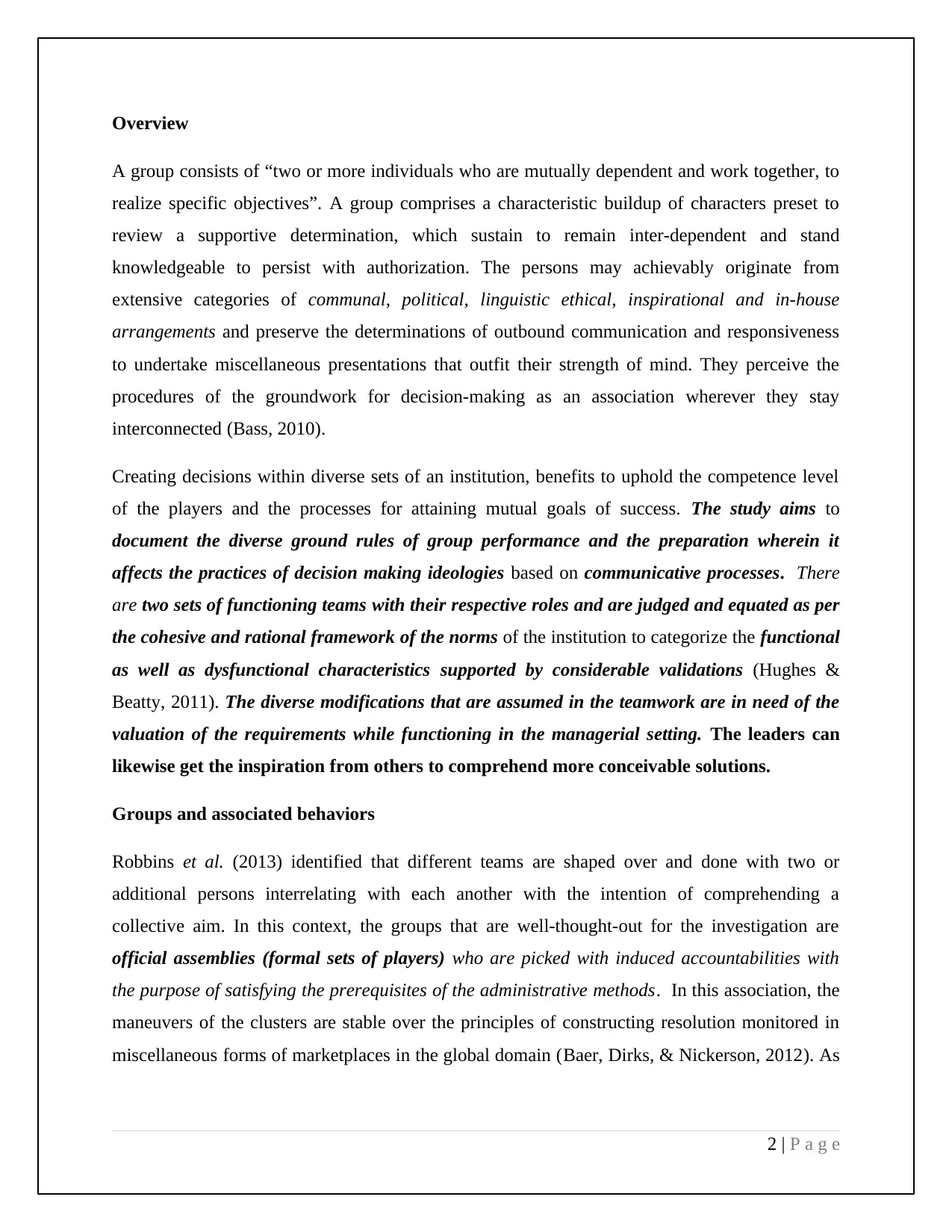
Overview
A group consists of “two or more individuals who are mutually dependent and work together, to
realize specific objectives”. A group comprises a characteristic buildup of characters preset to
review a supportive determination, which sustain to remain inter-dependent and stand
knowledgeable to persist with authorization. The persons may achievably originate from
extensive categories of communal, political, linguistic ethical, inspirational and in-house
arrangements and preserve the determinations of outbound communication and responsiveness
to undertake miscellaneous presentations that outfit their strength of mind. They perceive the
procedures of the groundwork for decision-making as an association wherever they stay
interconnected (Bass, 2010).
Creating decisions within diverse sets of an institution, benefits to uphold the competence level
of the players and the processes for attaining mutual goals of success. The study aims to
document the diverse ground rules of group performance and the preparation wherein it
affects the practices of decision making ideologies based on communicative processes. There
are two sets of functioning teams with their respective roles and are judged and equated as per
the cohesive and rational framework of the norms of the institution to categorize the functional
as well as dysfunctional characteristics supported by considerable validations (Hughes &
Beatty, 2011). The diverse modifications that are assumed in the teamwork are in need of the
valuation of the requirements while functioning in the managerial setting. The leaders can
likewise get the inspiration from others to comprehend more conceivable solutions.
Groups and associated behaviors
Robbins et al. (2013) identified that different teams are shaped over and done with two or
additional persons interrelating with each another with the intention of comprehending a
collective aim. In this context, the groups that are well-thought-out for the investigation are
official assemblies (formal sets of players) who are picked with induced accountabilities with
the purpose of satisfying the prerequisites of the administrative methods. In this association, the
maneuvers of the clusters are stable over the principles of constructing resolution monitored in
miscellaneous forms of marketplaces in the global domain (Baer, Dirks, & Nickerson, 2012). As
2 | P a g e
A group consists of “two or more individuals who are mutually dependent and work together, to
realize specific objectives”. A group comprises a characteristic buildup of characters preset to
review a supportive determination, which sustain to remain inter-dependent and stand
knowledgeable to persist with authorization. The persons may achievably originate from
extensive categories of communal, political, linguistic ethical, inspirational and in-house
arrangements and preserve the determinations of outbound communication and responsiveness
to undertake miscellaneous presentations that outfit their strength of mind. They perceive the
procedures of the groundwork for decision-making as an association wherever they stay
interconnected (Bass, 2010).
Creating decisions within diverse sets of an institution, benefits to uphold the competence level
of the players and the processes for attaining mutual goals of success. The study aims to
document the diverse ground rules of group performance and the preparation wherein it
affects the practices of decision making ideologies based on communicative processes. There
are two sets of functioning teams with their respective roles and are judged and equated as per
the cohesive and rational framework of the norms of the institution to categorize the functional
as well as dysfunctional characteristics supported by considerable validations (Hughes &
Beatty, 2011). The diverse modifications that are assumed in the teamwork are in need of the
valuation of the requirements while functioning in the managerial setting. The leaders can
likewise get the inspiration from others to comprehend more conceivable solutions.
Groups and associated behaviors
Robbins et al. (2013) identified that different teams are shaped over and done with two or
additional persons interrelating with each another with the intention of comprehending a
collective aim. In this context, the groups that are well-thought-out for the investigation are
official assemblies (formal sets of players) who are picked with induced accountabilities with
the purpose of satisfying the prerequisites of the administrative methods. In this association, the
maneuvers of the clusters are stable over the principles of constructing resolution monitored in
miscellaneous forms of marketplaces in the global domain (Baer, Dirks, & Nickerson, 2012). As
2 | P a g e
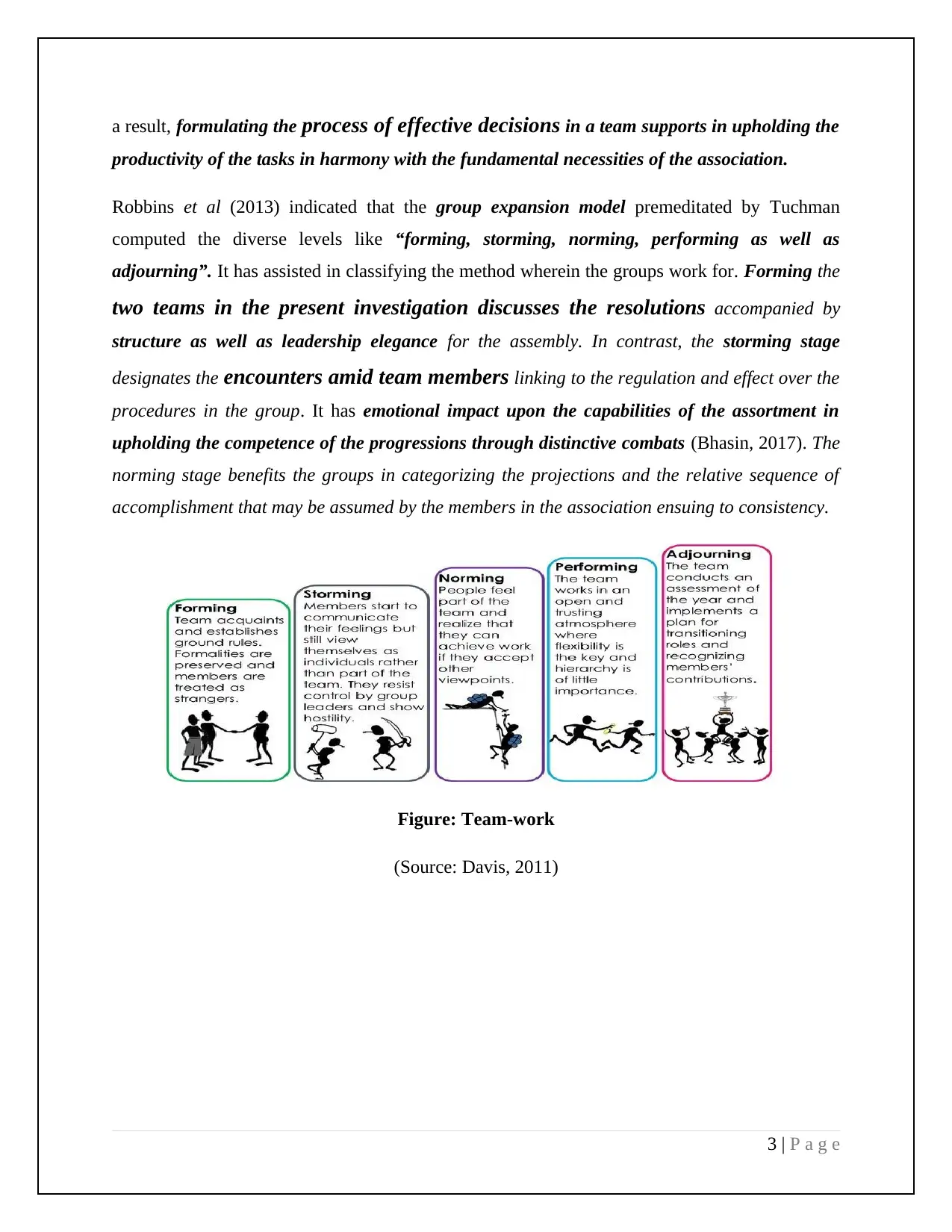
a result, formulating the process of effective decisions in a team supports in upholding the
productivity of the tasks in harmony with the fundamental necessities of the association.
Robbins et al (2013) indicated that the group expansion model premeditated by Tuchman
computed the diverse levels like “forming, storming, norming, performing as well as
adjourning”. It has assisted in classifying the method wherein the groups work for. Forming the
two teams in the present investigation discusses the resolutions accompanied by
structure as well as leadership elegance for the assembly. In contrast, the storming stage
designates the encounters amid team members linking to the regulation and effect over the
procedures in the group. It has emotional impact upon the capabilities of the assortment in
upholding the competence of the progressions through distinctive combats (Bhasin, 2017). The
norming stage benefits the groups in categorizing the projections and the relative sequence of
accomplishment that may be assumed by the members in the association ensuing to consistency.
Figure: Team-work
(Source: Davis, 2011)
3 | P a g e
productivity of the tasks in harmony with the fundamental necessities of the association.
Robbins et al (2013) indicated that the group expansion model premeditated by Tuchman
computed the diverse levels like “forming, storming, norming, performing as well as
adjourning”. It has assisted in classifying the method wherein the groups work for. Forming the
two teams in the present investigation discusses the resolutions accompanied by
structure as well as leadership elegance for the assembly. In contrast, the storming stage
designates the encounters amid team members linking to the regulation and effect over the
procedures in the group. It has emotional impact upon the capabilities of the assortment in
upholding the competence of the progressions through distinctive combats (Bhasin, 2017). The
norming stage benefits the groups in categorizing the projections and the relative sequence of
accomplishment that may be assumed by the members in the association ensuing to consistency.
Figure: Team-work
(Source: Davis, 2011)
3 | P a g e
⊘ This is a preview!⊘
Do you want full access?
Subscribe today to unlock all pages.

Trusted by 1+ million students worldwide
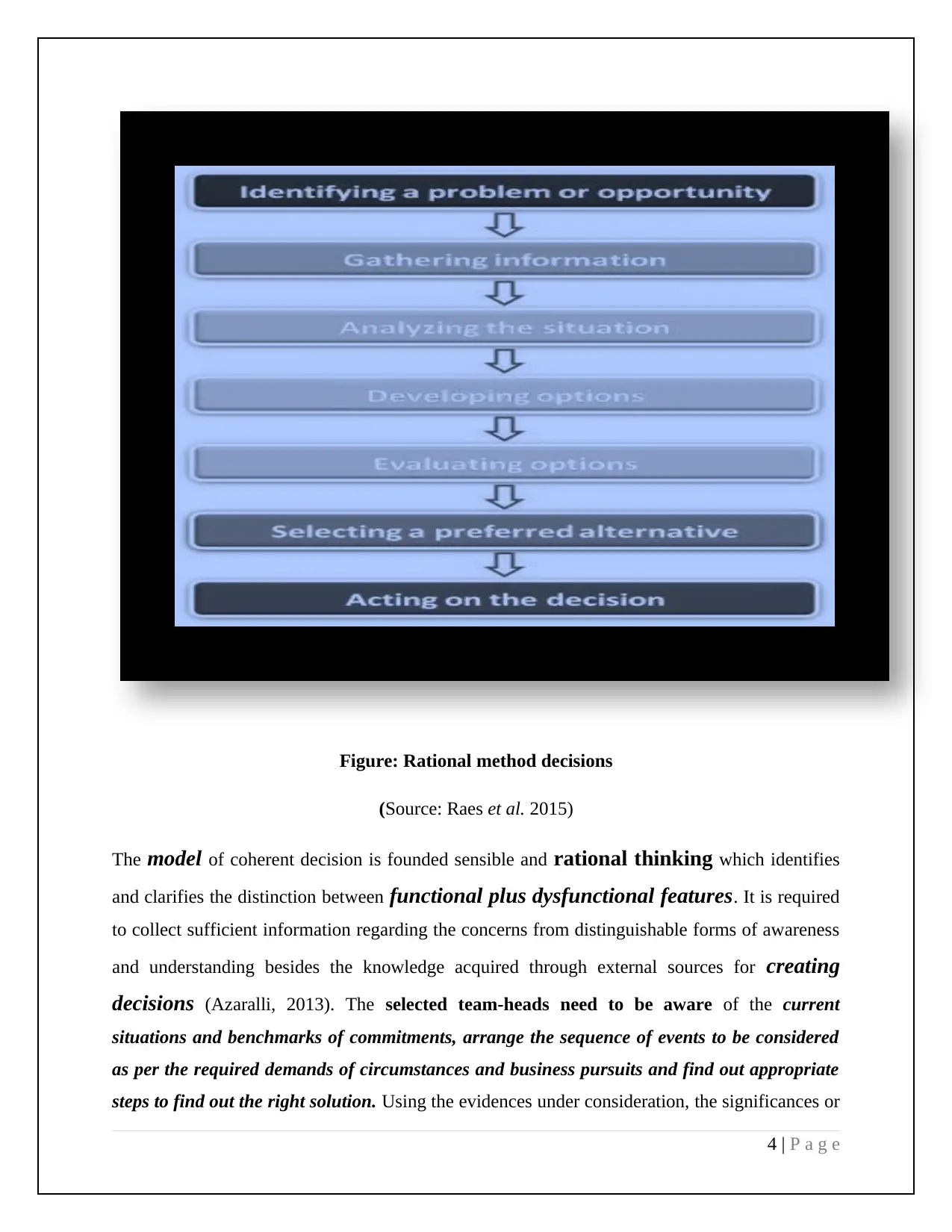
Figure: Rational method decisions
(Source: Raes et al. 2015)
The model of coherent decision is founded sensible and rational thinking which identifies
and clarifies the distinction between functional plus dysfunctional features. It is required
to collect sufficient information regarding the concerns from distinguishable forms of awareness
and understanding besides the knowledge acquired through external sources for creating
decisions (Azaralli, 2013). The selected team-heads need to be aware of the current
situations and benchmarks of commitments, arrange the sequence of events to be considered
as per the required demands of circumstances and business pursuits and find out appropriate
steps to find out the right solution. Using the evidences under consideration, the significances or
4 | P a g e
(Source: Raes et al. 2015)
The model of coherent decision is founded sensible and rational thinking which identifies
and clarifies the distinction between functional plus dysfunctional features. It is required
to collect sufficient information regarding the concerns from distinguishable forms of awareness
and understanding besides the knowledge acquired through external sources for creating
decisions (Azaralli, 2013). The selected team-heads need to be aware of the current
situations and benchmarks of commitments, arrange the sequence of events to be considered
as per the required demands of circumstances and business pursuits and find out appropriate
steps to find out the right solution. Using the evidences under consideration, the significances or
4 | P a g e
Paraphrase This Document
Need a fresh take? Get an instant paraphrase of this document with our AI Paraphraser
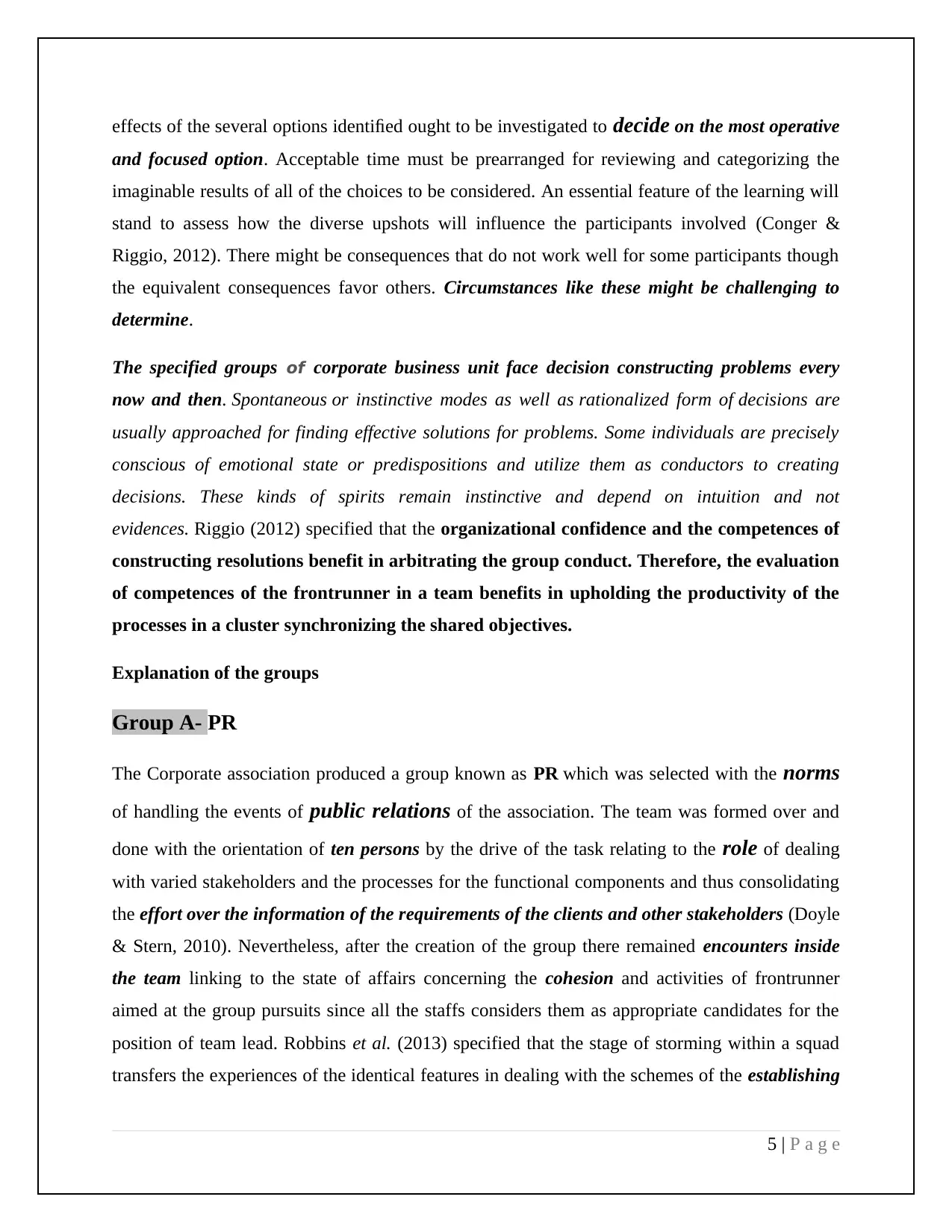
effects of the several options identified ought to be investigated to decide on the most operative
and focused option. Acceptable time must be prearranged for reviewing and categorizing the
imaginable results of all of the choices to be considered. An essential feature of the learning will
stand to assess how the diverse upshots will influence the participants involved (Conger &
Riggio, 2012). There might be consequences that do not work well for some participants though
the equivalent consequences favor others. Circumstances like these might be challenging to
determine.
The specified groups of corporate business unit face decision constructing problems every
now and then. Spontaneous or instinctive modes as well as rationalized form of decisions are
usually approached for finding effective solutions for problems. Some individuals are precisely
conscious of emotional state or predispositions and utilize them as conductors to creating
decisions. These kinds of spirits remain instinctive and depend on intuition and not
evidences. Riggio (2012) specified that the organizational confidence and the competences of
constructing resolutions benefit in arbitrating the group conduct. Therefore, the evaluation
of competences of the frontrunner in a team benefits in upholding the productivity of the
processes in a cluster synchronizing the shared objectives.
Explanation of the groups
Group A- PR
The Corporate association produced a group known as PR which was selected with the norms
of handling the events of public relations of the association. The team was formed over and
done with the orientation of ten persons by the drive of the task relating to the role of dealing
with varied stakeholders and the processes for the functional components and thus consolidating
the effort over the information of the requirements of the clients and other stakeholders (Doyle
& Stern, 2010). Nevertheless, after the creation of the group there remained encounters inside
the team linking to the state of affairs concerning the cohesion and activities of frontrunner
aimed at the group pursuits since all the staffs considers them as appropriate candidates for the
position of team lead. Robbins et al. (2013) specified that the stage of storming within a squad
transfers the experiences of the identical features in dealing with the schemes of the establishing
5 | P a g e
and focused option. Acceptable time must be prearranged for reviewing and categorizing the
imaginable results of all of the choices to be considered. An essential feature of the learning will
stand to assess how the diverse upshots will influence the participants involved (Conger &
Riggio, 2012). There might be consequences that do not work well for some participants though
the equivalent consequences favor others. Circumstances like these might be challenging to
determine.
The specified groups of corporate business unit face decision constructing problems every
now and then. Spontaneous or instinctive modes as well as rationalized form of decisions are
usually approached for finding effective solutions for problems. Some individuals are precisely
conscious of emotional state or predispositions and utilize them as conductors to creating
decisions. These kinds of spirits remain instinctive and depend on intuition and not
evidences. Riggio (2012) specified that the organizational confidence and the competences of
constructing resolutions benefit in arbitrating the group conduct. Therefore, the evaluation
of competences of the frontrunner in a team benefits in upholding the productivity of the
processes in a cluster synchronizing the shared objectives.
Explanation of the groups
Group A- PR
The Corporate association produced a group known as PR which was selected with the norms
of handling the events of public relations of the association. The team was formed over and
done with the orientation of ten persons by the drive of the task relating to the role of dealing
with varied stakeholders and the processes for the functional components and thus consolidating
the effort over the information of the requirements of the clients and other stakeholders (Doyle
& Stern, 2010). Nevertheless, after the creation of the group there remained encounters inside
the team linking to the state of affairs concerning the cohesion and activities of frontrunner
aimed at the group pursuits since all the staffs considers them as appropriate candidates for the
position of team lead. Robbins et al. (2013) specified that the stage of storming within a squad
transfers the experiences of the identical features in dealing with the schemes of the establishing
5 | P a g e

rational decisions. Subsequently, the deficiency of accurate documentation of the capabilities
of frontrunner in the cluster conveyed the image of irritated state of affairs. Six followers within
the association fingered that there remains a delicate variance in the level of superiority in the
midst of the participants while articulating the role of the team in the course of the working
procedures of the institute. Conversely, two of the associates were out of control to associate
them with the team which transfixed on their emphasis on the potentials of direction of activities
regardless of the readiness (Gillett, Ajasafe & Lovell, 2011).
Nevertheless, the leading encounter which was triggered by the cluster was owing to the
deficiency of transparency at the storming session. Alternatively, the tussles within the members
of the set blown up the talents and competences of the adherents in certifying the constructing
model for coherent decision with the purpose of sustaining the fabrication of the actions. t
biased the aptitudes of the assemblage in keeping the value of the functioning events in
consistent with the agreement of requirements of accomplishing the business target (Głowacki &
Jackson, 2014). The sketch of asymmetrical workstation and the activities attaching to flexibility
while involving the squad has bothered the experiences of fashioning judgments. In this
association, the set that was premeditated by the foundation diverged from the idealism of “five
steps” projected by Tuckman, and degenerated the skills of the group in maintaining the criterion
of the schedules in settlement to the collective drives (Conger & Riggio, 2012).
Group B- HR
The second group that was shaped by the Human Resource manager was HR. It was quite
valued owing to the insufficiency of frankness on resolution. The group strolled from the five-
step model planned by Tuchman, which produced the situation of inoperativeness in the leading
stage of the model. The team was made with eight members who were primarily very passionate
(Davis, 2011). Nevertheless, the deficiency of appropriate understanding on the determination of
norms of the association has influenced the aptitudes of the members and the functional
enterprise in sustaining the adeptness of the procedures rendering to the requirements of
accomplishing the shared roles. Gillett, Ajasafe, & Lovell, (2011) specified that the strong
declaration of firmness aids a collection in upholding the competence of the processes while
training the participants to remain aware of the procedures that they may follow. However,
6 | P a g e
of frontrunner in the cluster conveyed the image of irritated state of affairs. Six followers within
the association fingered that there remains a delicate variance in the level of superiority in the
midst of the participants while articulating the role of the team in the course of the working
procedures of the institute. Conversely, two of the associates were out of control to associate
them with the team which transfixed on their emphasis on the potentials of direction of activities
regardless of the readiness (Gillett, Ajasafe & Lovell, 2011).
Nevertheless, the leading encounter which was triggered by the cluster was owing to the
deficiency of transparency at the storming session. Alternatively, the tussles within the members
of the set blown up the talents and competences of the adherents in certifying the constructing
model for coherent decision with the purpose of sustaining the fabrication of the actions. t
biased the aptitudes of the assemblage in keeping the value of the functioning events in
consistent with the agreement of requirements of accomplishing the business target (Głowacki &
Jackson, 2014). The sketch of asymmetrical workstation and the activities attaching to flexibility
while involving the squad has bothered the experiences of fashioning judgments. In this
association, the set that was premeditated by the foundation diverged from the idealism of “five
steps” projected by Tuckman, and degenerated the skills of the group in maintaining the criterion
of the schedules in settlement to the collective drives (Conger & Riggio, 2012).
Group B- HR
The second group that was shaped by the Human Resource manager was HR. It was quite
valued owing to the insufficiency of frankness on resolution. The group strolled from the five-
step model planned by Tuchman, which produced the situation of inoperativeness in the leading
stage of the model. The team was made with eight members who were primarily very passionate
(Davis, 2011). Nevertheless, the deficiency of appropriate understanding on the determination of
norms of the association has influenced the aptitudes of the members and the functional
enterprise in sustaining the adeptness of the procedures rendering to the requirements of
accomplishing the shared roles. Gillett, Ajasafe, & Lovell, (2011) specified that the strong
declaration of firmness aids a collection in upholding the competence of the processes while
training the participants to remain aware of the procedures that they may follow. However,
6 | P a g e
⊘ This is a preview!⊘
Do you want full access?
Subscribe today to unlock all pages.

Trusted by 1+ million students worldwide
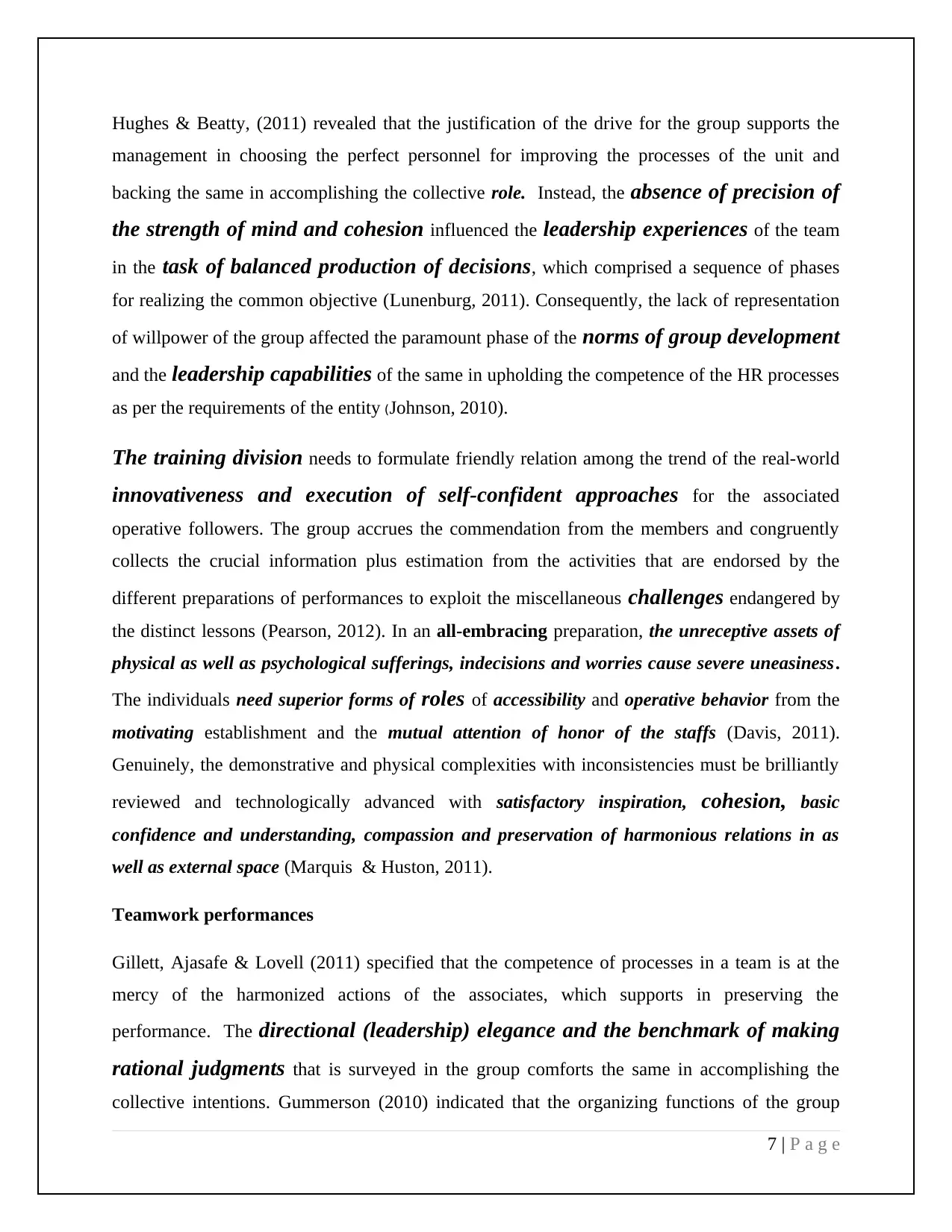
Hughes & Beatty, (2011) revealed that the justification of the drive for the group supports the
management in choosing the perfect personnel for improving the processes of the unit and
backing the same in accomplishing the collective role. Instead, the absence of precision of
the strength of mind and cohesion influenced the leadership experiences of the team
in the task of balanced production of decisions, which comprised a sequence of phases
for realizing the common objective (Lunenburg, 2011). Consequently, the lack of representation
of willpower of the group affected the paramount phase of the norms of group development
and the leadership capabilities of the same in upholding the competence of the HR processes
as per the requirements of the entity (Johnson, 2010).
The training division needs to formulate friendly relation among the trend of the real-world
innovativeness and execution of self-confident approaches for the associated
operative followers. The group accrues the commendation from the members and congruently
collects the crucial information plus estimation from the activities that are endorsed by the
different preparations of performances to exploit the miscellaneous challenges endangered by
the distinct lessons (Pearson, 2012). In an all-embracing preparation, the unreceptive assets of
physical as well as psychological sufferings, indecisions and worries cause severe uneasiness.
The individuals need superior forms of roles of accessibility and operative behavior from the
motivating establishment and the mutual attention of honor of the staffs (Davis, 2011).
Genuinely, the demonstrative and physical complexities with inconsistencies must be brilliantly
reviewed and technologically advanced with satisfactory inspiration, cohesion, basic
confidence and understanding, compassion and preservation of harmonious relations in as
well as external space (Marquis & Huston, 2011).
Teamwork performances
Gillett, Ajasafe & Lovell (2011) specified that the competence of processes in a team is at the
mercy of the harmonized actions of the associates, which supports in preserving the
performance. The directional (leadership) elegance and the benchmark of making
rational judgments that is surveyed in the group comforts the same in accomplishing the
collective intentions. Gummerson (2010) indicated that the organizing functions of the group
7 | P a g e
management in choosing the perfect personnel for improving the processes of the unit and
backing the same in accomplishing the collective role. Instead, the absence of precision of
the strength of mind and cohesion influenced the leadership experiences of the team
in the task of balanced production of decisions, which comprised a sequence of phases
for realizing the common objective (Lunenburg, 2011). Consequently, the lack of representation
of willpower of the group affected the paramount phase of the norms of group development
and the leadership capabilities of the same in upholding the competence of the HR processes
as per the requirements of the entity (Johnson, 2010).
The training division needs to formulate friendly relation among the trend of the real-world
innovativeness and execution of self-confident approaches for the associated
operative followers. The group accrues the commendation from the members and congruently
collects the crucial information plus estimation from the activities that are endorsed by the
different preparations of performances to exploit the miscellaneous challenges endangered by
the distinct lessons (Pearson, 2012). In an all-embracing preparation, the unreceptive assets of
physical as well as psychological sufferings, indecisions and worries cause severe uneasiness.
The individuals need superior forms of roles of accessibility and operative behavior from the
motivating establishment and the mutual attention of honor of the staffs (Davis, 2011).
Genuinely, the demonstrative and physical complexities with inconsistencies must be brilliantly
reviewed and technologically advanced with satisfactory inspiration, cohesion, basic
confidence and understanding, compassion and preservation of harmonious relations in as
well as external space (Marquis & Huston, 2011).
Teamwork performances
Gillett, Ajasafe & Lovell (2011) specified that the competence of processes in a team is at the
mercy of the harmonized actions of the associates, which supports in preserving the
performance. The directional (leadership) elegance and the benchmark of making
rational judgments that is surveyed in the group comforts the same in accomplishing the
collective intentions. Gummerson (2010) indicated that the organizing functions of the group
7 | P a g e
Paraphrase This Document
Need a fresh take? Get an instant paraphrase of this document with our AI Paraphraser
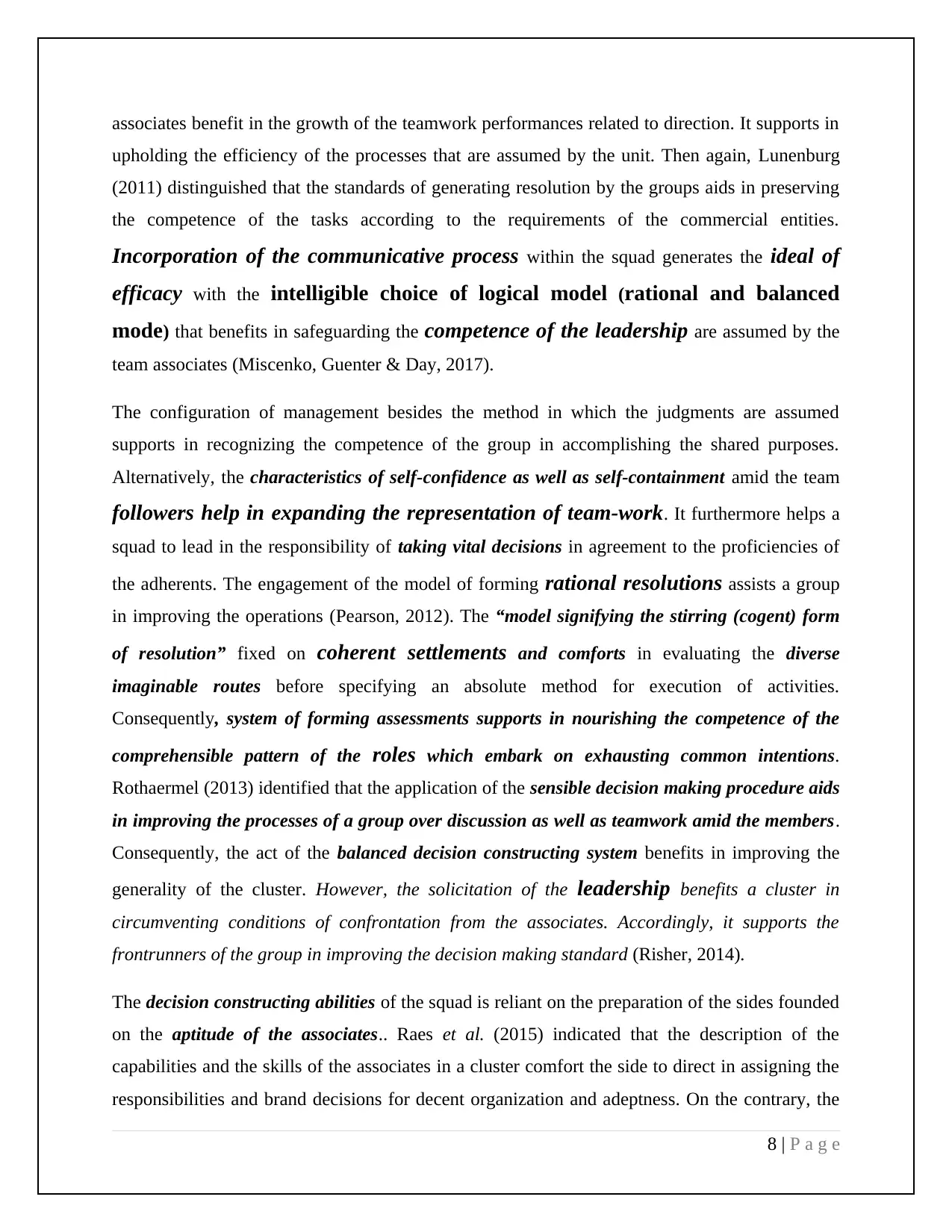
associates benefit in the growth of the teamwork performances related to direction. It supports in
upholding the efficiency of the processes that are assumed by the unit. Then again, Lunenburg
(2011) distinguished that the standards of generating resolution by the groups aids in preserving
the competence of the tasks according to the requirements of the commercial entities.
Incorporation of the communicative process within the squad generates the ideal of
efficacy with the intelligible choice of logical model (rational and balanced
mode) that benefits in safeguarding the competence of the leadership are assumed by the
team associates (Miscenko, Guenter & Day, 2017).
The configuration of management besides the method in which the judgments are assumed
supports in recognizing the competence of the group in accomplishing the shared purposes.
Alternatively, the characteristics of self-confidence as well as self-containment amid the team
followers help in expanding the representation of team-work. It furthermore helps a
squad to lead in the responsibility of taking vital decisions in agreement to the proficiencies of
the adherents. The engagement of the model of forming rational resolutions assists a group
in improving the operations (Pearson, 2012). The “model signifying the stirring (cogent) form
of resolution” fixed on coherent settlements and comforts in evaluating the diverse
imaginable routes before specifying an absolute method for execution of activities.
Consequently, system of forming assessments supports in nourishing the competence of the
comprehensible pattern of the roles which embark on exhausting common intentions.
Rothaermel (2013) identified that the application of the sensible decision making procedure aids
in improving the processes of a group over discussion as well as teamwork amid the members.
Consequently, the act of the balanced decision constructing system benefits in improving the
generality of the cluster. However, the solicitation of the leadership benefits a cluster in
circumventing conditions of confrontation from the associates. Accordingly, it supports the
frontrunners of the group in improving the decision making standard (Risher, 2014).
The decision constructing abilities of the squad is reliant on the preparation of the sides founded
on the aptitude of the associates.. Raes et al. (2015) indicated that the description of the
capabilities and the skills of the associates in a cluster comfort the side to direct in assigning the
responsibilities and brand decisions for decent organization and adeptness. On the contrary, the
8 | P a g e
upholding the efficiency of the processes that are assumed by the unit. Then again, Lunenburg
(2011) distinguished that the standards of generating resolution by the groups aids in preserving
the competence of the tasks according to the requirements of the commercial entities.
Incorporation of the communicative process within the squad generates the ideal of
efficacy with the intelligible choice of logical model (rational and balanced
mode) that benefits in safeguarding the competence of the leadership are assumed by the
team associates (Miscenko, Guenter & Day, 2017).
The configuration of management besides the method in which the judgments are assumed
supports in recognizing the competence of the group in accomplishing the shared purposes.
Alternatively, the characteristics of self-confidence as well as self-containment amid the team
followers help in expanding the representation of team-work. It furthermore helps a
squad to lead in the responsibility of taking vital decisions in agreement to the proficiencies of
the adherents. The engagement of the model of forming rational resolutions assists a group
in improving the operations (Pearson, 2012). The “model signifying the stirring (cogent) form
of resolution” fixed on coherent settlements and comforts in evaluating the diverse
imaginable routes before specifying an absolute method for execution of activities.
Consequently, system of forming assessments supports in nourishing the competence of the
comprehensible pattern of the roles which embark on exhausting common intentions.
Rothaermel (2013) identified that the application of the sensible decision making procedure aids
in improving the processes of a group over discussion as well as teamwork amid the members.
Consequently, the act of the balanced decision constructing system benefits in improving the
generality of the cluster. However, the solicitation of the leadership benefits a cluster in
circumventing conditions of confrontation from the associates. Accordingly, it supports the
frontrunners of the group in improving the decision making standard (Risher, 2014).
The decision constructing abilities of the squad is reliant on the preparation of the sides founded
on the aptitude of the associates.. Raes et al. (2015) indicated that the description of the
capabilities and the skills of the associates in a cluster comfort the side to direct in assigning the
responsibilities and brand decisions for decent organization and adeptness. On the contrary, the
8 | P a g e
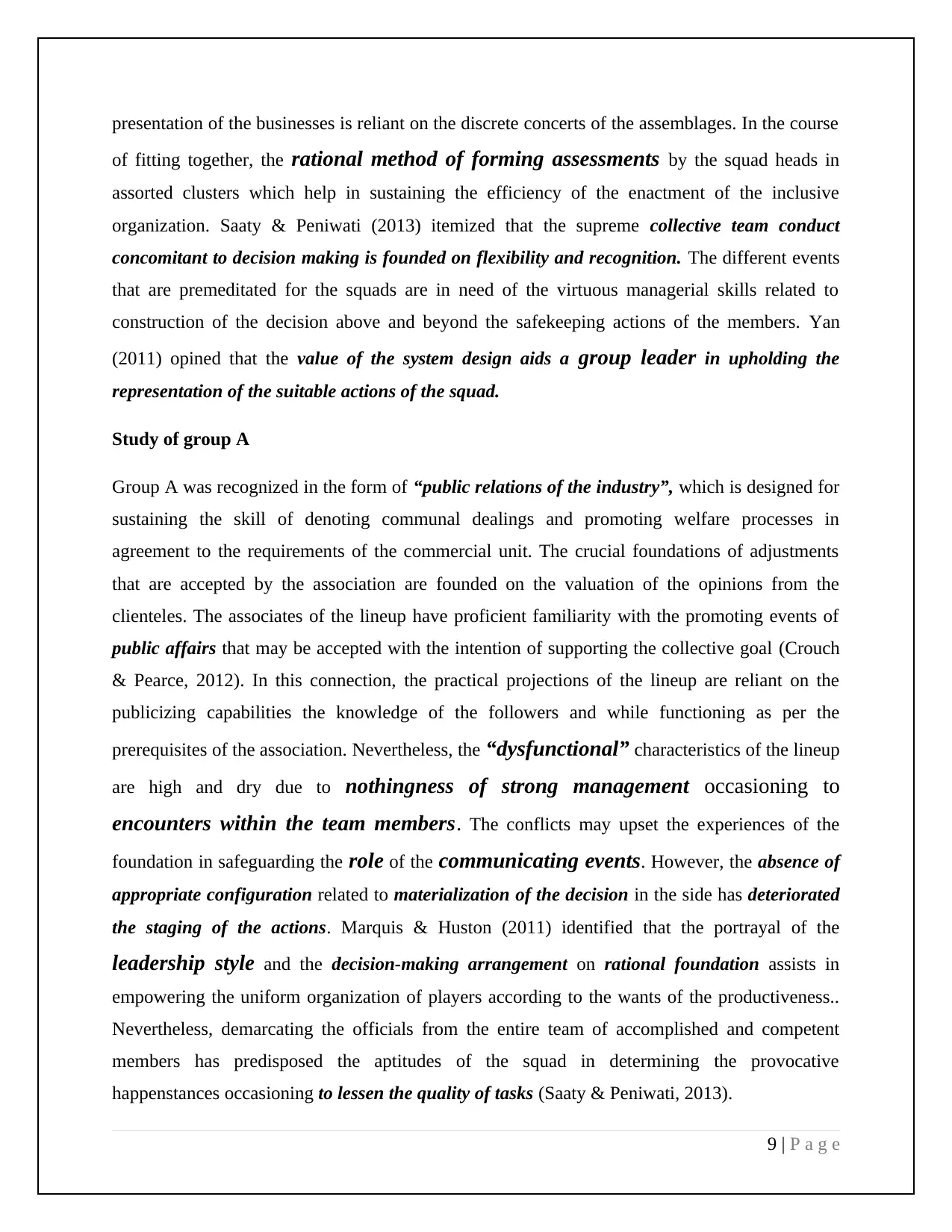
presentation of the businesses is reliant on the discrete concerts of the assemblages. In the course
of fitting together, the rational method of forming assessments by the squad heads in
assorted clusters which help in sustaining the efficiency of the enactment of the inclusive
organization. Saaty & Peniwati (2013) itemized that the supreme collective team conduct
concomitant to decision making is founded on flexibility and recognition. The different events
that are premeditated for the squads are in need of the virtuous managerial skills related to
construction of the decision above and beyond the safekeeping actions of the members. Yan
(2011) opined that the value of the system design aids a group leader in upholding the
representation of the suitable actions of the squad.
Study of group A
Group A was recognized in the form of “public relations of the industry”, which is designed for
sustaining the skill of denoting communal dealings and promoting welfare processes in
agreement to the requirements of the commercial unit. The crucial foundations of adjustments
that are accepted by the association are founded on the valuation of the opinions from the
clienteles. The associates of the lineup have proficient familiarity with the promoting events of
public affairs that may be accepted with the intention of supporting the collective goal (Crouch
& Pearce, 2012). In this connection, the practical projections of the lineup are reliant on the
publicizing capabilities the knowledge of the followers and while functioning as per the
prerequisites of the association. Nevertheless, the “dysfunctional” characteristics of the lineup
are high and dry due to nothingness of strong management occasioning to
encounters within the team members. The conflicts may upset the experiences of the
foundation in safeguarding the role of the communicating events. However, the absence of
appropriate configuration related to materialization of the decision in the side has deteriorated
the staging of the actions. Marquis & Huston (2011) identified that the portrayal of the
leadership style and the decision-making arrangement on rational foundation assists in
empowering the uniform organization of players according to the wants of the productiveness..
Nevertheless, demarcating the officials from the entire team of accomplished and competent
members has predisposed the aptitudes of the squad in determining the provocative
happenstances occasioning to lessen the quality of tasks (Saaty & Peniwati, 2013).
9 | P a g e
of fitting together, the rational method of forming assessments by the squad heads in
assorted clusters which help in sustaining the efficiency of the enactment of the inclusive
organization. Saaty & Peniwati (2013) itemized that the supreme collective team conduct
concomitant to decision making is founded on flexibility and recognition. The different events
that are premeditated for the squads are in need of the virtuous managerial skills related to
construction of the decision above and beyond the safekeeping actions of the members. Yan
(2011) opined that the value of the system design aids a group leader in upholding the
representation of the suitable actions of the squad.
Study of group A
Group A was recognized in the form of “public relations of the industry”, which is designed for
sustaining the skill of denoting communal dealings and promoting welfare processes in
agreement to the requirements of the commercial unit. The crucial foundations of adjustments
that are accepted by the association are founded on the valuation of the opinions from the
clienteles. The associates of the lineup have proficient familiarity with the promoting events of
public affairs that may be accepted with the intention of supporting the collective goal (Crouch
& Pearce, 2012). In this connection, the practical projections of the lineup are reliant on the
publicizing capabilities the knowledge of the followers and while functioning as per the
prerequisites of the association. Nevertheless, the “dysfunctional” characteristics of the lineup
are high and dry due to nothingness of strong management occasioning to
encounters within the team members. The conflicts may upset the experiences of the
foundation in safeguarding the role of the communicating events. However, the absence of
appropriate configuration related to materialization of the decision in the side has deteriorated
the staging of the actions. Marquis & Huston (2011) identified that the portrayal of the
leadership style and the decision-making arrangement on rational foundation assists in
empowering the uniform organization of players according to the wants of the productiveness..
Nevertheless, demarcating the officials from the entire team of accomplished and competent
members has predisposed the aptitudes of the squad in determining the provocative
happenstances occasioning to lessen the quality of tasks (Saaty & Peniwati, 2013).
9 | P a g e
⊘ This is a preview!⊘
Do you want full access?
Subscribe today to unlock all pages.

Trusted by 1+ million students worldwide
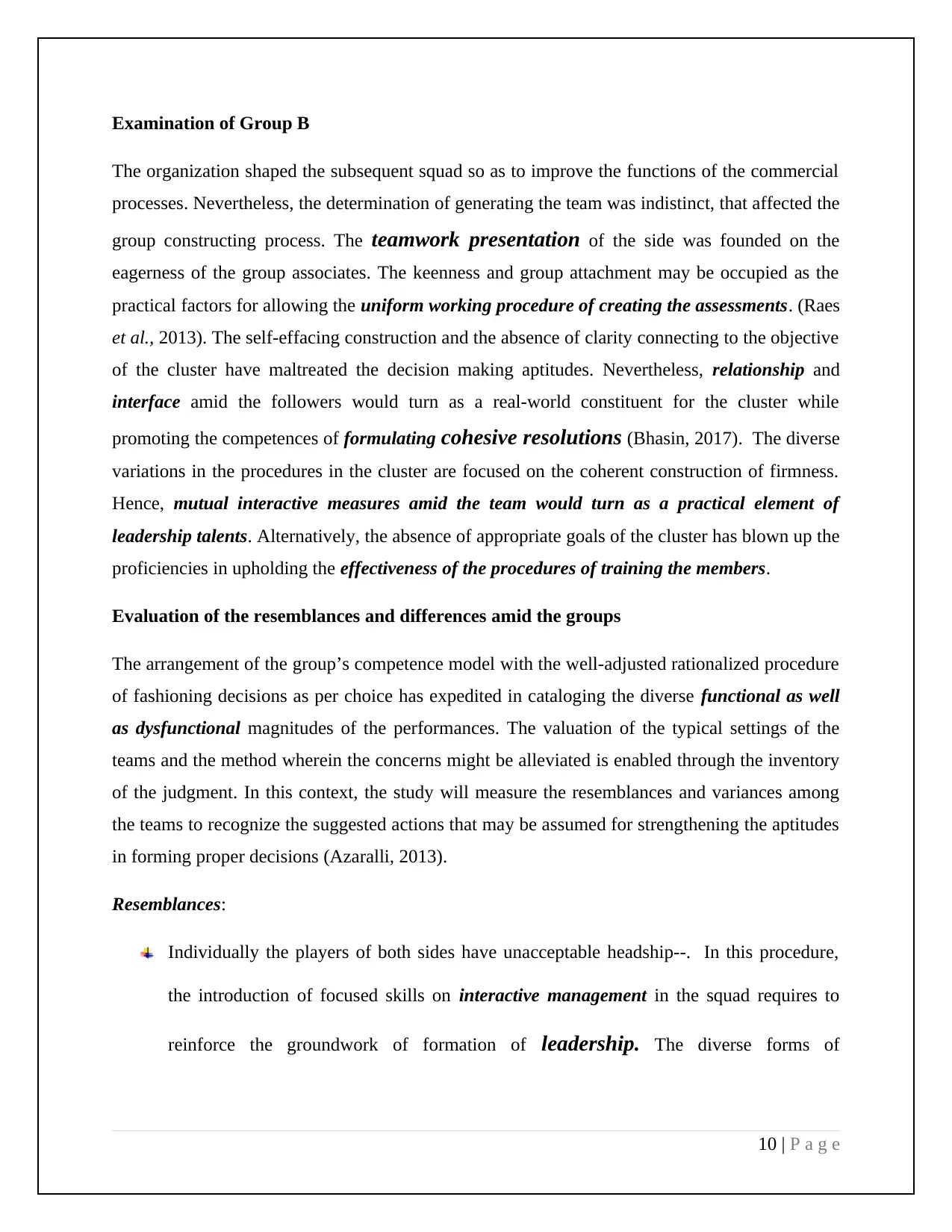
Examination of Group B
The organization shaped the subsequent squad so as to improve the functions of the commercial
processes. Nevertheless, the determination of generating the team was indistinct, that affected the
group constructing process. The teamwork presentation of the side was founded on the
eagerness of the group associates. The keenness and group attachment may be occupied as the
practical factors for allowing the uniform working procedure of creating the assessments. (Raes
et al., 2013). The self-effacing construction and the absence of clarity connecting to the objective
of the cluster have maltreated the decision making aptitudes. Nevertheless, relationship and
interface amid the followers would turn as a real-world constituent for the cluster while
promoting the competences of formulating cohesive resolutions (Bhasin, 2017). The diverse
variations in the procedures in the cluster are focused on the coherent construction of firmness.
Hence, mutual interactive measures amid the team would turn as a practical element of
leadership talents. Alternatively, the absence of appropriate goals of the cluster has blown up the
proficiencies in upholding the effectiveness of the procedures of training the members.
Evaluation of the resemblances and differences amid the groups
The arrangement of the group’s competence model with the well-adjusted rationalized procedure
of fashioning decisions as per choice has expedited in cataloging the diverse functional as well
as dysfunctional magnitudes of the performances. The valuation of the typical settings of the
teams and the method wherein the concerns might be alleviated is enabled through the inventory
of the judgment. In this context, the study will measure the resemblances and variances among
the teams to recognize the suggested actions that may be assumed for strengthening the aptitudes
in forming proper decisions (Azaralli, 2013).
Resemblances:
Individually the players of both sides have unacceptable headship--. In this procedure,
the introduction of focused skills on interactive management in the squad requires to
reinforce the groundwork of formation of leadership. The diverse forms of
10 | P a g e
The organization shaped the subsequent squad so as to improve the functions of the commercial
processes. Nevertheless, the determination of generating the team was indistinct, that affected the
group constructing process. The teamwork presentation of the side was founded on the
eagerness of the group associates. The keenness and group attachment may be occupied as the
practical factors for allowing the uniform working procedure of creating the assessments. (Raes
et al., 2013). The self-effacing construction and the absence of clarity connecting to the objective
of the cluster have maltreated the decision making aptitudes. Nevertheless, relationship and
interface amid the followers would turn as a real-world constituent for the cluster while
promoting the competences of formulating cohesive resolutions (Bhasin, 2017). The diverse
variations in the procedures in the cluster are focused on the coherent construction of firmness.
Hence, mutual interactive measures amid the team would turn as a practical element of
leadership talents. Alternatively, the absence of appropriate goals of the cluster has blown up the
proficiencies in upholding the effectiveness of the procedures of training the members.
Evaluation of the resemblances and differences amid the groups
The arrangement of the group’s competence model with the well-adjusted rationalized procedure
of fashioning decisions as per choice has expedited in cataloging the diverse functional as well
as dysfunctional magnitudes of the performances. The valuation of the typical settings of the
teams and the method wherein the concerns might be alleviated is enabled through the inventory
of the judgment. In this context, the study will measure the resemblances and variances among
the teams to recognize the suggested actions that may be assumed for strengthening the aptitudes
in forming proper decisions (Azaralli, 2013).
Resemblances:
Individually the players of both sides have unacceptable headship--. In this procedure,
the introduction of focused skills on interactive management in the squad requires to
reinforce the groundwork of formation of leadership. The diverse forms of
10 | P a g e
Paraphrase This Document
Need a fresh take? Get an instant paraphrase of this document with our AI Paraphraser
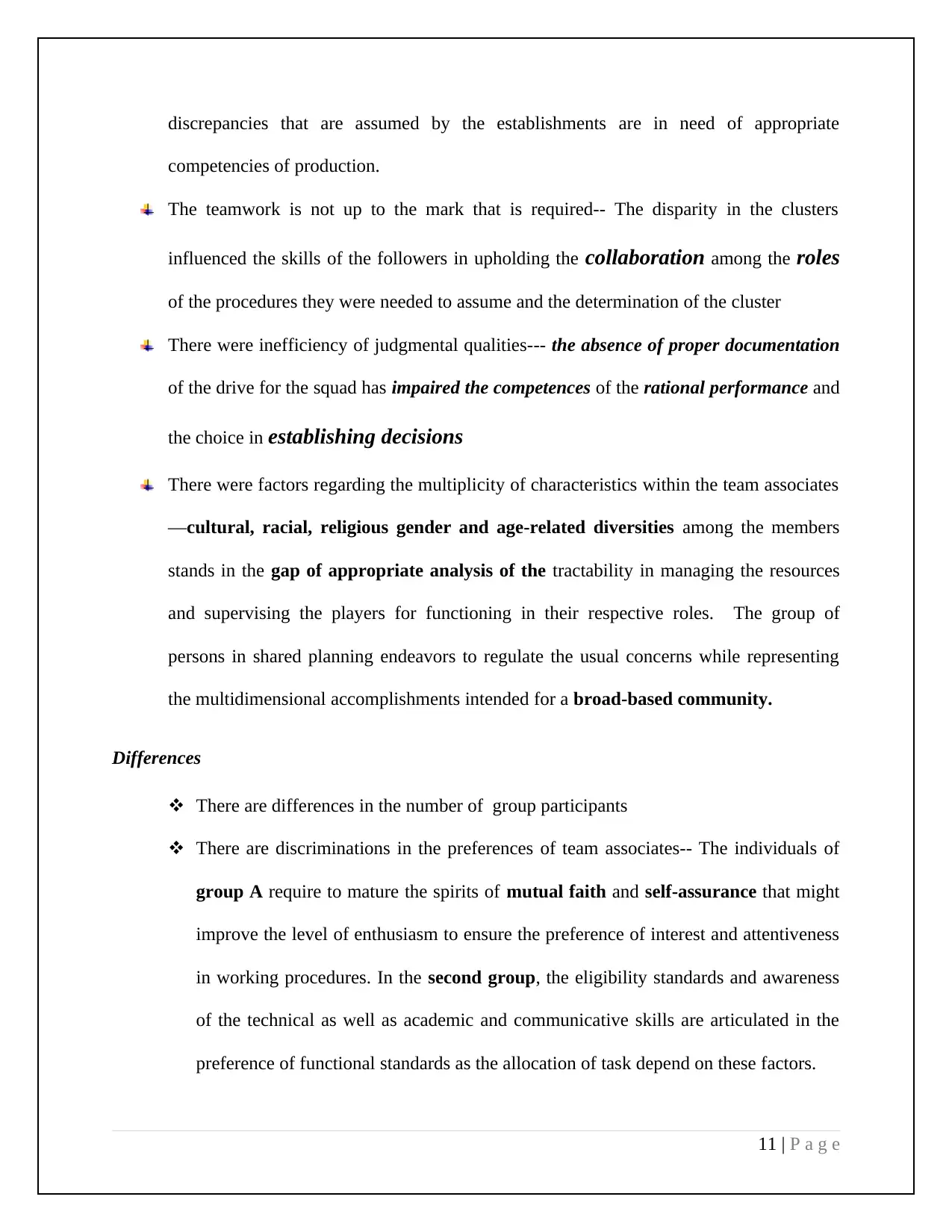
discrepancies that are assumed by the establishments are in need of appropriate
competencies of production.
The teamwork is not up to the mark that is required-- The disparity in the clusters
influenced the skills of the followers in upholding the collaboration among the roles
of the procedures they were needed to assume and the determination of the cluster
There were inefficiency of judgmental qualities--- the absence of proper documentation
of the drive for the squad has impaired the competences of the rational performance and
the choice in establishing decisions
There were factors regarding the multiplicity of characteristics within the team associates
—cultural, racial, religious gender and age-related diversities among the members
stands in the gap of appropriate analysis of the tractability in managing the resources
and supervising the players for functioning in their respective roles. The group of
persons in shared planning endeavors to regulate the usual concerns while representing
the multidimensional accomplishments intended for a broad-based community.
Differences
There are differences in the number of group participants
There are discriminations in the preferences of team associates-- The individuals of
group A require to mature the spirits of mutual faith and self-assurance that might
improve the level of enthusiasm to ensure the preference of interest and attentiveness
in working procedures. In the second group, the eligibility standards and awareness
of the technical as well as academic and communicative skills are articulated in the
preference of functional standards as the allocation of task depend on these factors.
11 | P a g e
competencies of production.
The teamwork is not up to the mark that is required-- The disparity in the clusters
influenced the skills of the followers in upholding the collaboration among the roles
of the procedures they were needed to assume and the determination of the cluster
There were inefficiency of judgmental qualities--- the absence of proper documentation
of the drive for the squad has impaired the competences of the rational performance and
the choice in establishing decisions
There were factors regarding the multiplicity of characteristics within the team associates
—cultural, racial, religious gender and age-related diversities among the members
stands in the gap of appropriate analysis of the tractability in managing the resources
and supervising the players for functioning in their respective roles. The group of
persons in shared planning endeavors to regulate the usual concerns while representing
the multidimensional accomplishments intended for a broad-based community.
Differences
There are differences in the number of group participants
There are discriminations in the preferences of team associates-- The individuals of
group A require to mature the spirits of mutual faith and self-assurance that might
improve the level of enthusiasm to ensure the preference of interest and attentiveness
in working procedures. In the second group, the eligibility standards and awareness
of the technical as well as academic and communicative skills are articulated in the
preference of functional standards as the allocation of task depend on these factors.
11 | P a g e

The pattern of team-work and mutual faith within the group adherents creates the
differences—in the first group, the application of the communal and legitimate
norms besides the involvement of the personnel govern the values of contentment
while executing the respective roles and duties.
In the second case, ineffective cluster is shaped through the documentation of the
fluctuating level of competences and capabilities of the followers.
The encounters amid the team-members varies in nature of group-members for each
side.-- In the first group, the variations in the performance of the team associates are
hooked on the useful and give-and-take role accomplished to maintain the confidence
of the team presentation. The stressful situations discharge the instincts of pressures
that source fluctuating dispositions at work. The competence level differs within the group members between the teams-- the
escalating share of disappointment amongst the associates of each side has blown up
the competences in accomplishing the collective motivation. The competencies at
effort are better met through suitable forms of consumption of the possessions and
material resources plus capitals accompanied by the truthful attitude and opinions
of the individuals.
Recommendations for each group
Recommendations for Group A
Discussions of the Objectives of Communicative, societal and cohesive strategy
The discussions related to confirmations of the objectives of linking of employees need to
emphasize on the performances of leading the reflection of definite introductions and
determinations that challenge the influenced obstructions of decisions within conflicting mind-
12 | P a g e
differences—in the first group, the application of the communal and legitimate
norms besides the involvement of the personnel govern the values of contentment
while executing the respective roles and duties.
In the second case, ineffective cluster is shaped through the documentation of the
fluctuating level of competences and capabilities of the followers.
The encounters amid the team-members varies in nature of group-members for each
side.-- In the first group, the variations in the performance of the team associates are
hooked on the useful and give-and-take role accomplished to maintain the confidence
of the team presentation. The stressful situations discharge the instincts of pressures
that source fluctuating dispositions at work. The competence level differs within the group members between the teams-- the
escalating share of disappointment amongst the associates of each side has blown up
the competences in accomplishing the collective motivation. The competencies at
effort are better met through suitable forms of consumption of the possessions and
material resources plus capitals accompanied by the truthful attitude and opinions
of the individuals.
Recommendations for each group
Recommendations for Group A
Discussions of the Objectives of Communicative, societal and cohesive strategy
The discussions related to confirmations of the objectives of linking of employees need to
emphasize on the performances of leading the reflection of definite introductions and
determinations that challenge the influenced obstructions of decisions within conflicting mind-
12 | P a g e
⊘ This is a preview!⊘
Do you want full access?
Subscribe today to unlock all pages.

Trusted by 1+ million students worldwide
1 out of 18
Your All-in-One AI-Powered Toolkit for Academic Success.
+13062052269
info@desklib.com
Available 24*7 on WhatsApp / Email
![[object Object]](/_next/static/media/star-bottom.7253800d.svg)
Unlock your academic potential
Copyright © 2020–2025 A2Z Services. All Rights Reserved. Developed and managed by ZUCOL.
